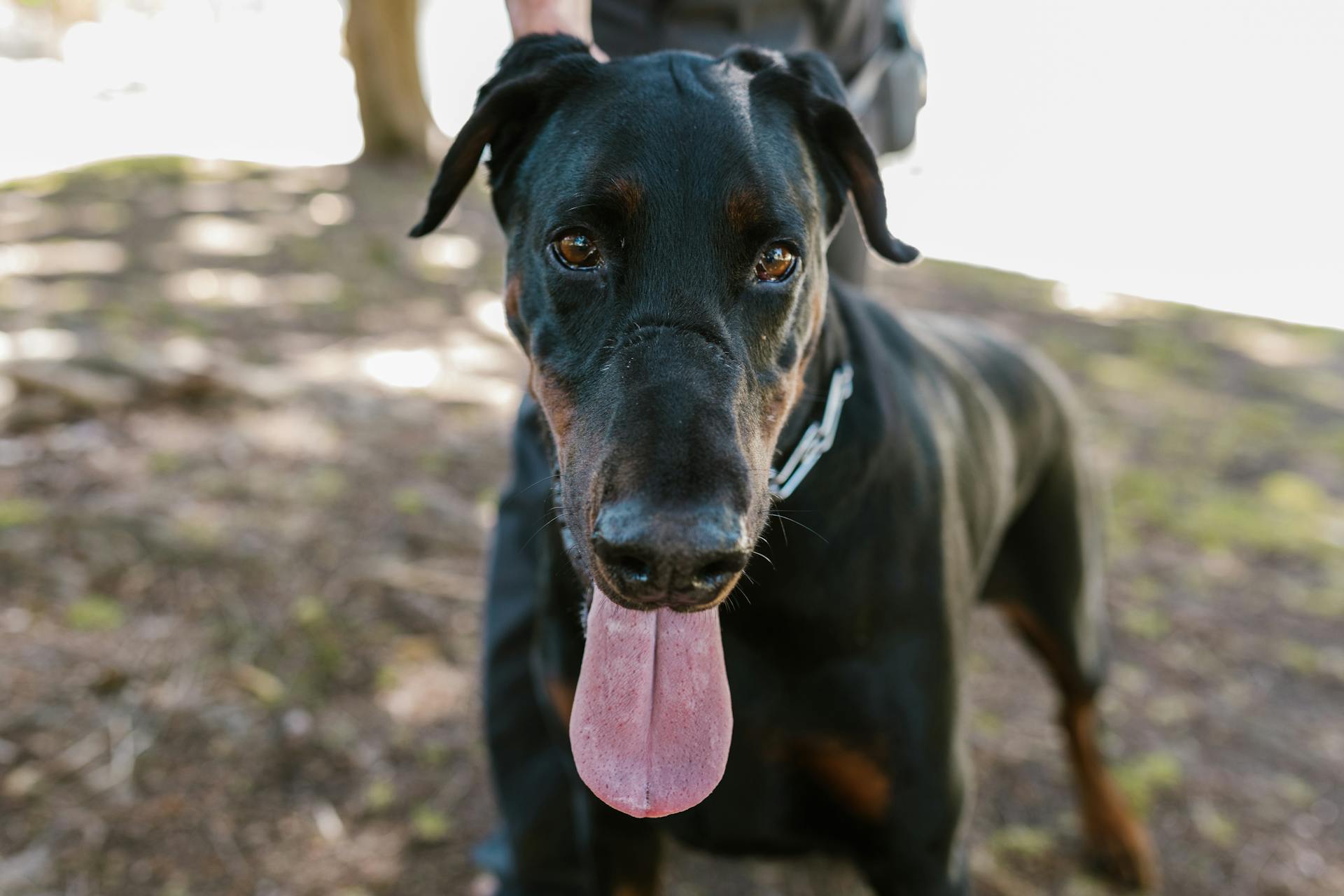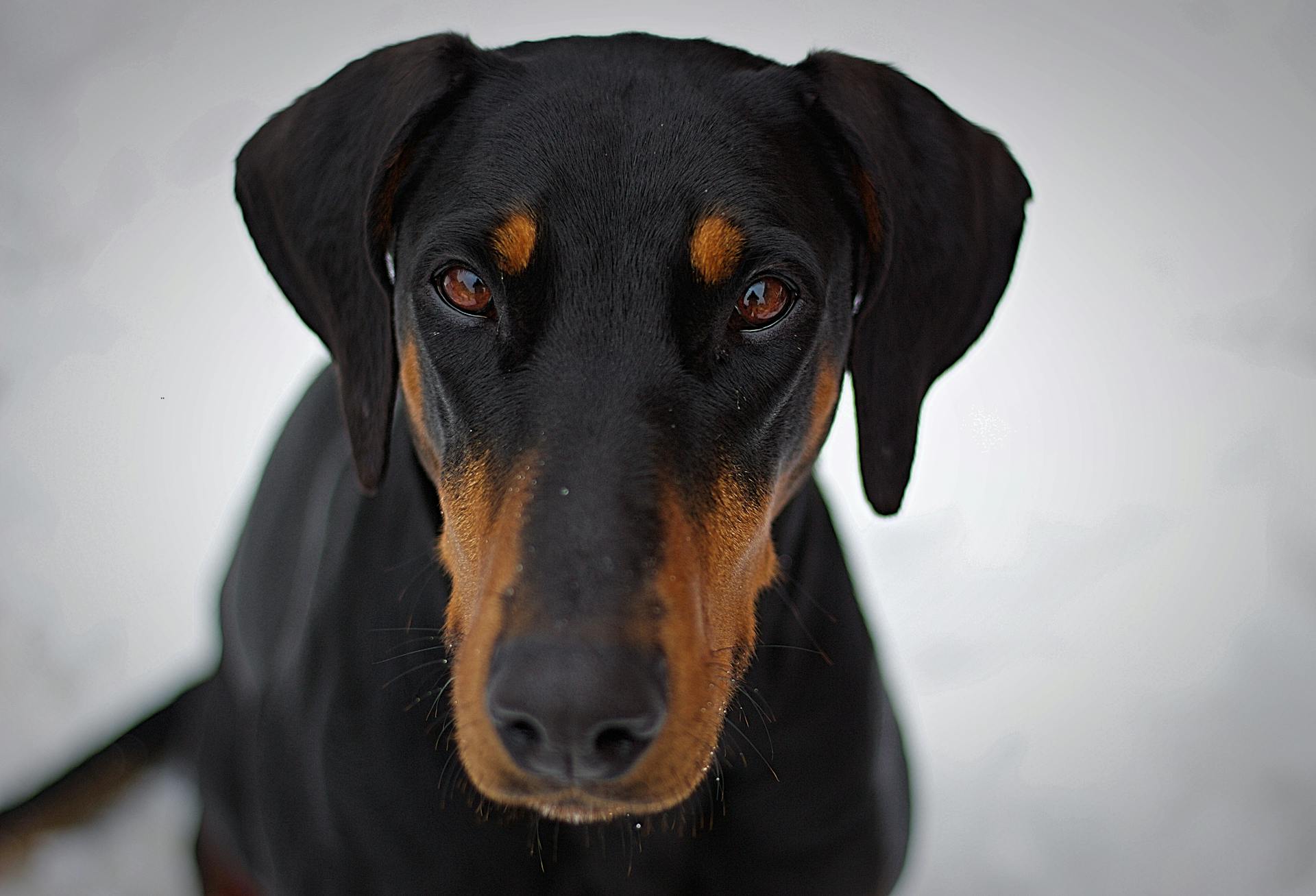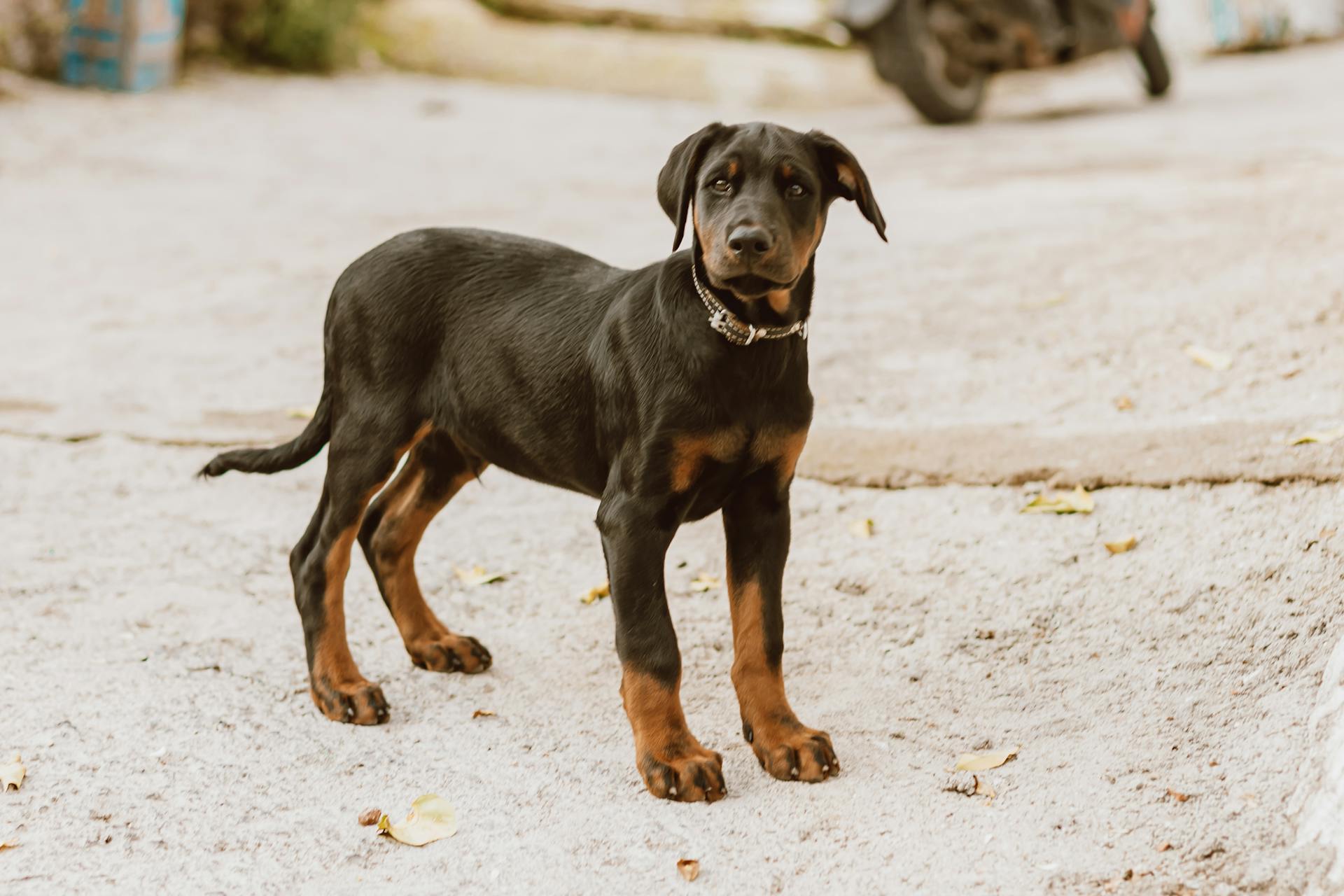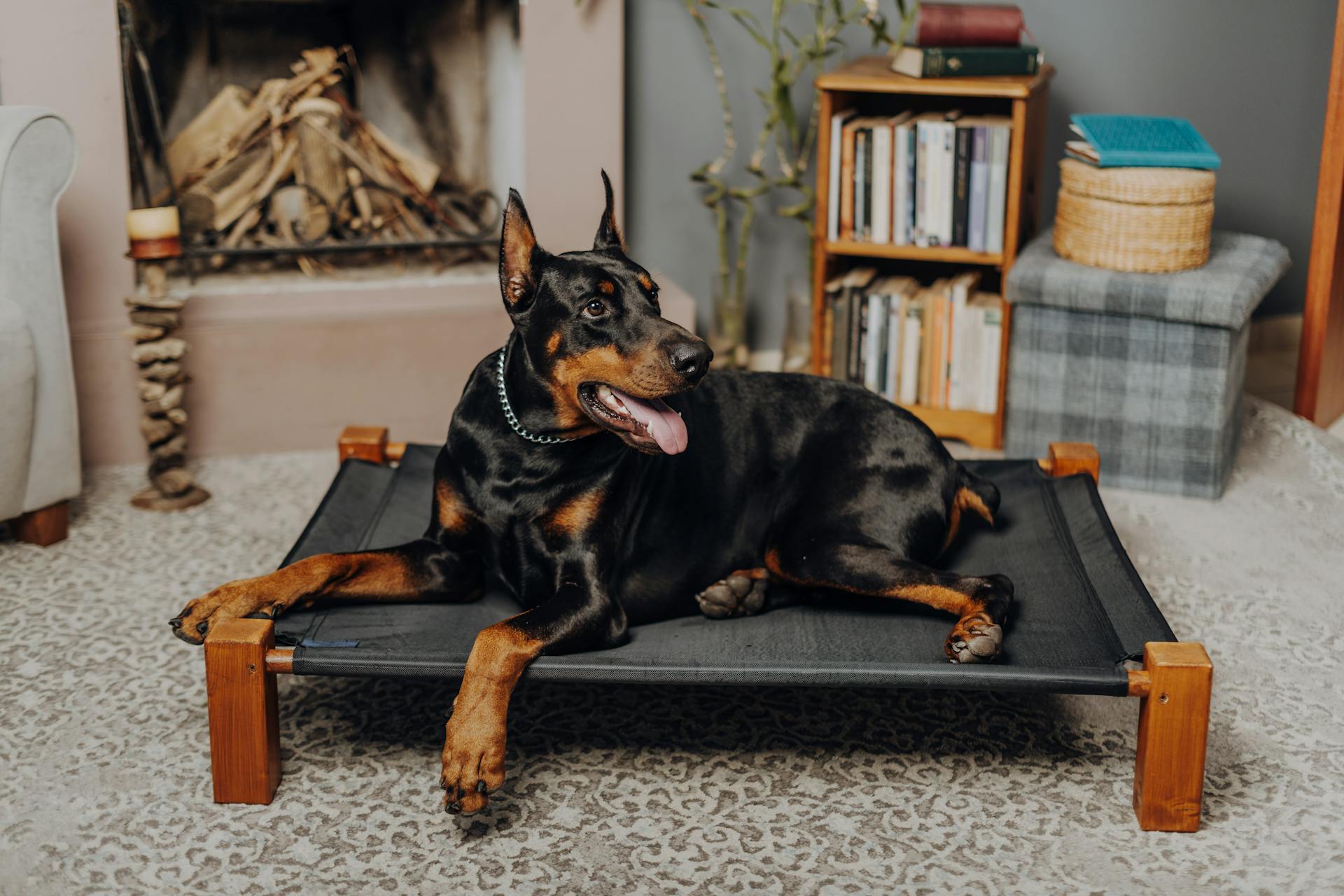
Raising a happy and healthy Doberman Pinscher puppy requires attention to their unique needs from an early age.
Doberman Pinschers are naturally intelligent dogs that thrive on mental stimulation and physical exercise. They need regular training sessions starting from 8 weeks old to develop good behavior and prevent unwanted habits.
Socialization is key in the first few months, as it helps your Doberman Pinscher puppy become confident and calm in new environments and around strangers.
A well-balanced diet rich in protein and moderate in fat is essential for a Doberman Pinscher's growth and development.
Suggestion: Doberman Puppy Ear Cropping
Doberman Pinscher Basics
Doberman Pinschers need clear and consistent guidance from their owners to thrive.
They have a strong need for direction and boundaries, which helps them feel secure and develop good behavior.
This breed requires training from puppyhood through adulthood, with a focus on establishing who's in charge and what's expected of them.
With proper training, Doberman Pinschers can become reliable working dogs or loving companions.
Their intelligence and power make them a great asset, but also demand responsible handling.
The breed was originally created as a companion dog by Louis Dobermann in Germany.
Doberman Pinschers are known for their loyalty, courage, and vigilance traits that made them valuable during World War II.
Additional reading: Obedience Training for Doberman Pinscher
Growth and Development
At six months old, a Doberman Pinscher puppy will already be quite large. A male can weigh between 50 to 65 pounds, while a female typically weighs between 45 to 55 pounds.
As your Doberman grows, you'll want to keep an eye on their size and development. One way to estimate how much bigger they'll get is by looking at their paws - if they're oversized next to their body, they're probably still filling out and growing.
Most Dobermans need at least a year to reach their full height, with some needing up to two years to fill out their chest. This can vary depending on factors like age, gender, and even the size of their parents.
If you have a female Doberman, be aware that they'll likely be considerably smaller than a male. And if you're curious about your puppy's potential adult weight, try talking to their breeder - they can give you an idea based on past litters and the size of the parents.
Discover more: Lab Doberman Mix Puppy
Here are some key factors to keep in mind when estimating your Doberman's growth:
- Age: Most Dobermans need at least a year to reach full height.
- Paw Size: Oversized paws can indicate that they're still growing.
- Gender: Males tend to be larger than females.
- Parents: A puppy's adult weight is often similar to their bigger parent.
By understanding these factors, you'll have a better idea of what to expect as your Doberman grows and develops. With patience and proper care, they'll reach their full potential in no time!
Health and Care
As a Doberman Pinscher owner, you want to give your puppy the best possible start in life. Regular veterinary care is essential for screening common health problems and monitoring weight and growth.
Doberman Pinschers are prone to certain genetic diseases, including cancer, wobbler syndrome, dilated cardiomyopathy (DCM), bloat, and liver inflammation.
Keep in mind that Dobermans are at a higher risk of developing dilated cardiomyopathy, with estimates suggesting it may affect almost half of all Dobermans at some point in their life. This can lead to congestive heart failure or even sudden death.
A unique perspective: Dilated Cardiomyopathy in Doberman Pinschers
Ensuring Your Pet's Health
Regular veterinary care is a must for your Doberman Pinscher to stay healthy.
Doberman Pinschers are at a higher risk of genetic diseases due to their purebred status.
Routine vet exams allow your veterinarian to screen for common health problems and monitor weight and growth.
Dilated cardiomyopathy affects almost half of all Dobermans at some point in their life, making it crucial to catch any issues early on.
Your vet can give you personalized recommendations for your puppy's care based on routine exams.
It's estimated that dilated cardiomyopathy may cause congestive heart failure or sudden death if left untreated.
Evaluating Quality
The Doberman can make an excellent family pet if properly trained and socialized.
Their loyalty to family members is unmatched, making them a great companion for many families.
However, it's essential to ensure children know how to behave respectfully around dogs.
With proper training and care, your Doberman will be a loving and playful member of the household.
Necessity of Ear Cropping
Ear cropping is a surgical procedure that has been performed on Doberman puppies at around 8 to 12 weeks of age.
The ears are then taped to a hard surface for several weeks while they heal, and this is done so that the ears will stay upright.
It's essential to note that ear cropping has no known health benefit and is done solely at the dog owner's preference.
Ear cropping is becoming less common as fewer veterinarians are willing to perform the surgery and dog owners become more aware of its controversial nature.
The American Veterinary Medical Association (AVMA) opposes ear cropping in dogs because it poses unnecessary risks to the dog, and they believe it's a purely cosmetic procedure.
Dogs without docked tails or cropped ears are just as likely to win at dog shows, according to the AKC.
A fresh viewpoint: Doberman Pinscher with Ears
Training and Behavior
Doberman Pinschers need clear and consistent guidance from their owners to thrive. They are intelligent dogs that can learn quickly if trained correctly.
Their strong desire to please their pack leader makes them open to training, but without it, they can become aggressive or develop bad habits. This is especially true for a breed like the Doberman, which needs structure and boundaries to feel secure.
In fact, socialization is crucial between 8-16 weeks of age, as this helps your puppy interact with other dogs and people in a positive way. By exposing them to various objects, textures, and stimuli from an early age, you can help prevent anxiety or fear-based behaviors later on.
Here's a general timeline for training your Doberman Pinscher:
- 10 days: exposure to objects, textures, and other stimuli
- 8 weeks: basic obedience commands (i.e., Sit, Lie Down, Come, Drop It, Release), tricks, crate training, potty training
- 12-14 weeks: basic obedience training (including Stay, Off, Leave it)
- 16 weeks – 6 months: stop biting training
- 6-8 months: off-leash training
- 6-12 months: impulse control; explore dog sports
By following this timeline and providing consistent guidance, you can help your Doberman Pinscher puppy grow into a well-behaved and loyal companion.
Be the Pack Leader Your Dog Needs
Being a pack leader is not about being the alpha dog, but rather about providing clear guidance and structure for your Doberman puppy to thrive. You need to be able to tell your new Doberman puppy what you expect them to do without wavering.
Dobermans are intelligent and powerful dogs that require consistent training from an early age. Without it, they can become aggressive or develop bad habits.
Check this out: Blue Steel Blue Doberman Puppies
To establish yourself as the pack leader, start by setting clear boundaries and expectations for your puppy's behavior. This will help them understand who is in charge and what to do.
Doberman puppies need to learn basic obedience commands, such as Sit, Lie Down, Come, Drop It, Release, and more, starting from around 8 weeks old. Crate training and potty training are also essential during this period.
Here's a general idea of the ages at which your Doberman puppy should start learning various things:
Remember to reward good behavior and be patient with your puppy as they learn. With consistent training and positive reinforcement, you can help your Doberman become a well-behaved and loving companion.
Parenting with Children
If you're considering a Doberman pinscher as part of your family, it's essential to understand their temperament and needs.
Dobermans are loyal and protective but can be mean or aggressive if improperly bred or raised.

Children need to learn how to respect dogs, especially high-energy breeds like Dobermans.
A well-trained Doberman is loving, playful, and affectionate towards its family members.
However, a Doberman puppy's rambunctious behavior may not be suitable for small children who can get hurt easily.
It's crucial to teach your children how to interact with dogs gently, without rough play that might cause the dog to lash out.
Doberman Pinscher Characteristics
Doberman Pinschers are strong and intelligent working breeds with high prey and defense drives. They're naturally good at reading human emotions and always eager to please their owners.
Their dedication to their family is unwavering once a relationship is established. They thrive on routines and do well when they know what to expect.
Their Characteristics
Doberman Pinschers are a strong and intelligent breed.
They're highly driven by their prey and defense instincts, making them excel at tasks they're trained for.
These dogs are incredibly good at reading human emotions and are eager to please their owners.
Once you establish a relationship with your Doberman Pinscher, they'll be dedicated to you and want to spend as much time together as possible.
They thrive on routines and do well when they know what to expect.
Without enough exercise and mental stimulation, Doberman Pinschers can become destructive.
German Tax Collector Breeds Them

A German tax collector named Karl Friedrich Louis Dobermann was the original breeder of the Doberman Pinscher breed.
Dobermann worked as a security guard and police officer, but it was his role as a tax collector that led him to create this breed. He needed a dog to protect him while on the road making collections.
As a dog pound owner, Dobermann had access to various breeds and experience working with them. This expertise helped him combine different breeds to create the perfect guard dog.
Dobermann's vision for the ideal guard dog was born out of his practical needs as a tax collector, and he successfully bred the Doberman Pinscher breed.
Worth a look: Doberman Pinscher Standard
Care and Living
Doberman Pinschers are active dogs that need regular exercise to stay happy and healthy. They require at least one hour of physical activity daily.
To keep your Doberman Pinscher puppy entertained and exercised, you'll want to engage them in activities like running, playing fetch, or going for a swim.
As they grow older, you can gradually increase the intensity and duration of their exercise routine.
However, if you live in an apartment, it's not impossible to have a Doberman Pinscher as long as you're prepared to offer regular walks and ensure your pup gets enough daily exercise.
A fresh viewpoint: Doberman Pinscher Exercise Needs
Interesting Facts
Doberman Pinschers are naturally loyal dogs and can become great companions if socialized properly from an early age.
Their short coats require minimal grooming compared to other breeds with long fur.
They're highly intelligent and respond well to positive reinforcement training methods.
With proper exercise, a Doberman Pinscher puppy can live up to 10-12 years or more.
Frequently Asked Questions
Are Doberman Pinscher good family dogs?
Yes, Doberman Pinschers can be good family dogs with proper training and socialization. However, close supervision is necessary when interacting with children due to their strong instincts.
How much should I pay for a Doberman puppy?
You can expect to pay between $1,000 and $2,500+ for a Doberman puppy from a reputable breeder. Prices may vary depending on factors like bloodline and show quality.
Are Dobermans high maintenance?
Yes, Dobermans are considered high maintenance due to their need for extensive exercise and ongoing training. Experienced owners who can commit time and effort are best suited to care for these dogs.
How big do doberman pinschers get?
Doberman Pinschers typically weigh between 60-100 pounds and stand 24-28 inches tall. Males are generally larger than females.
What is the difference between a Doberman and Doberman Pinscher?
In North America, "Doberman Pinscher" is used, while outside of this region, the breed is simply called a Dobermann. This difference in naming reflects changes in the breed's appearance over time.
Sources
- https://www.pawlicy.com/blog/doberman-pinscher-growth-and-weight-chart/
- https://k9basics.com/how-to-train-a-doberman-pinscher/
- https://www.dogster.com/lifestyle/doberman-pinscher-facts
- https://dpca.org/breeded/is-a-doberman-the-right-breed-for-you/
- https://www.petplace.com/article/dogs/breeds/dog-breeds/everything-family-needs-know-doberman-breed
Featured Images: pexels.com

